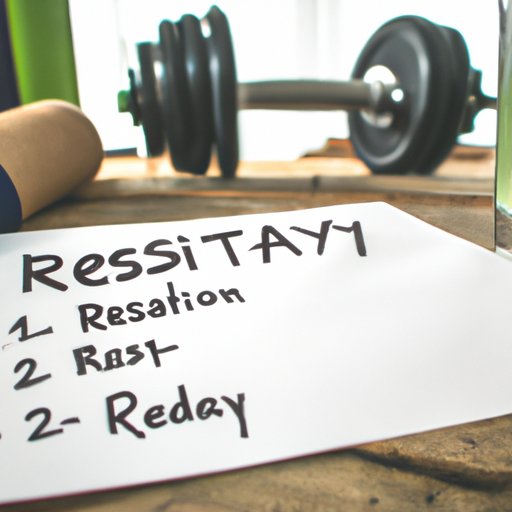Introduction
Taking a rest day from working out is an important part of any fitness routine. A rest day is a day that you don’t do any physical activity—it’s a day to give your body a chance to recover and rebuild itself. Rest days are essential for improving performance, preventing injury, and helping you reach your fitness goals.

How to Tell When You Need a Break From Exercise
Knowing when it’s time to take a rest day can be tricky, especially if you’re trying to stay consistent with your workouts. Here are some signs that you may need a break:
- You’re feeling unusually tired or sluggish during your workouts.
- You’re not seeing progress in your strength or endurance.
- You’re experiencing muscle soreness or joint pain.
- You’re feeling unmotivated or uninterested in exercising.
If you’re experiencing any of these signs, it may be time to take a break. There are several strategies you can use to help you decide if a rest day is necessary:
- Pay attention to how your body feels. If you’re feeling unusually tired or sore, it may be time to take a rest day.
- Listen to your mental state. If you’re feeling unmotivated or uninterested in exercising, it may be time to take a break.
- Keep track of your progress. If you’re not seeing progress in your strength or endurance, it may be time for a rest day.
- Talk to your doctor or a fitness professional. They can help you determine if a rest day is necessary.
The Science Behind Rest Days and Their Impact on Your Fitness Goals
Rest days are essential for optimal performance and reaching your fitness goals. Physiologically, rest days give your body a chance to repair and rebuild itself. During periods of rest, your body releases hormones that stimulate muscle growth and repair damaged cells. This helps reduce muscle soreness and fatigue and improves overall performance.
Rest days also help improve your focus and motivation. Taking a break from exercise gives your mind a chance to recharge and refocus on your goals. Additionally, taking regular rest days helps prevent burnout and allows you to come back to exercise feeling energized and motivated.
How to Structure Your Workouts For Optimal Performance and Recovery
Planning your workouts strategically can help maximize performance and recovery. Scheduling rest days into your routine is key for optimizing your workouts and achieving your fitness goals. Aim to take one or two rest days per week, depending on your fitness level and goals. If you’re just starting out, it’s best to start with one rest day and gradually increase as you become more experienced.

Tips for Incorporating Rest Days Into Your Regular Routine
Making rest days part of your regular routine is essential for optimal performance and recovery. Here are some tips for incorporating rest days into your routine:
- Plan ahead. Schedule your rest days in advance so you know exactly when to take a break.
- Be consistent. Try to take your rest days at the same time each week to create a regular routine.
- Be flexible. It’s ok to adjust your rest days if needed. Just make sure you’re still getting enough rest.
- Stick to your plan. Once you’ve set a schedule, try your best to stick to it.

What to Do On Rest Days to Maximize Recovery
Rest days are important for giving your body a chance to recover and rebuild itself. Here are some activities you can do on rest days to maximize recovery:
- Active recovery. Participate in light activities such as walking or stretching to help reduce muscle soreness and fatigue.
- Proper nutrition. Eating nutrient-rich foods on rest days can help replenish energy stores and aid in recovery.
Common Mistakes to Avoid When Planning Rest Days
Not scheduling enough rest days or not taking full advantage of them can have negative effects on your performance and recovery. Here are some common mistakes to avoid when planning rest days:
- Not scheduling enough rest days. Aim to take one or two rest days per week, depending on your fitness level and goals.
- Not taking full advantage of rest days. Use your rest days to give your body a chance to recover and rebuild itself.
Conclusion
Rest days are an essential part of any workout routine. Knowing when to take a rest day and how to incorporate them into your regular routine can help you reach your fitness goals and maximize performance and recovery. By paying attention to your body and planning your workouts strategically, you can make the most of your rest days and achieve long-term success.
(Note: Is this article not meeting your expectations? Do you have knowledge or insights to share? Unlock new opportunities and expand your reach by joining our authors team. Click Registration to join us and share your expertise with our readers.)
